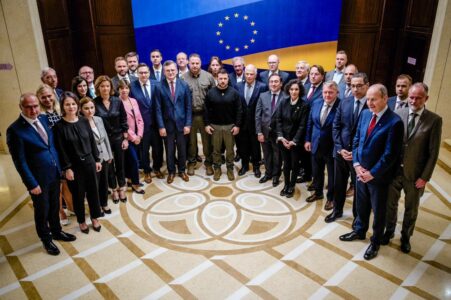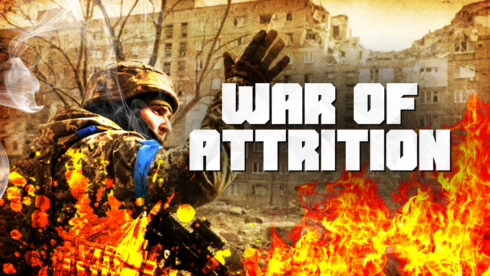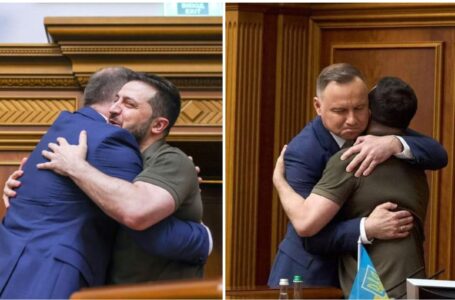Written by Pietro Pinter, a Doctor in International Relations, author of italian-language geopolitics blog inimicizie.com
In recent days, Kiev has been hit by a whirlwind of high-level foreign delegations. At the beginning of last week, a meeting was held between the Ukrainian authorities and representatives of the major arms industries of NATO countries – mainly European, with a particularly important presence of the British, French and Czechs – with defence ministry officials in tow.
On the agenda, the future role of the European military-industrial complex in the proxy war: the direction that seems to have emerged is that of new production lines in Ukraine itself, established by European companies, financed by national governments and the European Union.
Industries such as Reihnmetall, BAE Systems and Bayraktyar have already expressed their intention to open plants in Ukraine in the near future.
The Ukrainian strategy is clear: in a war of attrition – which Kiev has not managed to turn into a war of movement by deploying the best armoured force NATO countries could assemble for the occasion – all that matters is the ability (combined with the will) to sustain the conflict for a longer period of time than your adversary. A change of strategy is needed, as the Economist’s new cover makes clear.
Localising the production of armaments through joint ventures obviates both problems: it provides a continuous flow of war material – with stocks that non-US allies can and want to supply de facto depleted by now – that is not dependent on the political will of the allies, while making logistics from the factory to the front less costly along the way.
Kiev – this much is clear by now – will not be able to enjoy the level of foreign support it has obtained so far for the entire duration of the conflict. The exhaustion of supplies that can be transferred without excessive burdens and ‘political fatigue’ (increasing for different reasons in the US and Europe) make it imperative for Ukraine to turn to a more autarkic strategy: one-off deliveries from countries not involved in the conflict – such as the one from Pakistan, negotiated in exchange for an IMF loan – can only be considered as a palliative, perhaps able to buffer the needs of the Ukrainian armed forces during an offensive, but not able to change the course of the war.
In the last month alone: Poland has declared that it is not willing to provide new military aid to Ukraine beyond that previously promised, the French air force chief has declared that his country is no longer able to supply weapons systems – echoed by an anonymous British colleague in the Telegraph – the US has passed a budget without aid to Ukraine, and EU foreign ministers – meeting in Kiev – have failed to agree on a new aid package in the wake of former Prime Minister Robert Fico’s election victory in Slovakia, which threatens to make future deliberations even more difficult.
Aid for Ukraine will not stop overnight – no doubt new aid packages will be approved on both sides of the ocean – but the country is preparing to rely less and less on its allies (in addition to threatening them with unrest in Ukrainian communities abroad, and humiliating its main European supporter at a press conference).
Moving arms production in-house, however – although a rational and justified decision – also entails major risks for Ukraine. Being dependent on factories subjected to the fire of the Russian armed forces implies an advantage for Moscow, which is able to hit Ukrainian territory deeper and with more fire volume than Kiev is able to do on Russian territory. The gradual decay of the Ukrainian anti-aircraft system – which is difficult to make up with NATO systems or the delivery of a few dozen F-16s – has made possible, since last spring, the massive use of Russian aerospace forces in the tactical and strategic bombing function, made possible by a huge Soviet stockpile of FAB-500 bombs (and similar variants) modernised with ‘smart kits’ produced at low cost and high volume.
A volume of fire necessary to hit reinforced, extensive and partly even underground armament factories – a ‘happy’ legacy of the Soviet Union for which Ukraine is certainly grateful – as the repeated attacks in recent months against the Kharkov tank factory have shown. A volume of fire that Ukraine, on the other hand, does not have: although it has proved capable of repeatedly striking sensitive Russian targets – the most egregious of which is the Engels airbase, home of the Tupolev strategic bombers, hundreds of kilometres from the Ukrainian border – a real, constant threat to the Russian military-industrial complex, to the reinforced industrial plants of Kurgan, Nizny Tagil, Omsk and Komsomolsk on Amur – located well across the Volga, also a Stalinist legacy – is beyond Kiev’s material capabilities. Taking out a Soviet military-industrial plant requires a volume of fire exponentially greater than that required to destroy a bomber on a runway or strike the headquarters of the Black Sea Fleet, no matter how effective these actions have been. Not even the SCALP, ATACMS and Taurus missiles (also systems whose quantity will necessarily be limited) will be able to change this strategic reality, due to their limited range.
Added to this is a political problem: shifting production to Ukraine will not be possible without foreign companies. These private companies – which have not yet been specific in terms of when and how they will set up in Ukraine – are unlikely to establish themselves in a war zone – not even in western Ukraine, where the threat is reduced to ‘only’ medium-range missiles and Shahed/Geran drones – without major political and financial guarantees from their own governments, thus making Ukrainian arms production politically conditionable from abroad. A political conditioning that threatens to become even stronger if – as one can reasonably imagine – these joint ventures will require the presence of many European technicians on site.
The transition to a war of attrition for Kiev is obligatory, but it will not be without difficulty. Ukraine will have to insulate itself as much as possible from external political winds, but in doing so it will have to gradually do without the security inherent in having the centre of origin of its armaments under the NATO nuclear umbrella.









